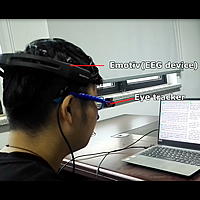
Reading comprehension based on visualization of eye tracking and EEG data
Cheng, Shiwei; Hu, Yilin; Fan, Jing; Wei, Qianjing
Sci China Inf Sci, 2020, 63(11): 214101
Using eye tracking technology can help us understand reading behavior. Furthermore, sharing the teacher's eye tracking features resulted in improving the students' comprehension of the same reading material. On the other hand, a user's intention can be analyzed by physiological data, such as electroencephalogram (EEG). EEG is closely related to human cognition. Recently, researchers have tried to use EEG-based engagement measures to augment learning activities. The BRAVO system constantly analyzes users' brain activity, and estimates their attention and meditation levels, and presents users with learning material that only results in high engagement. FOCUS is an EEG augmented reading system that monitors a child's engagement level in real time, and it provides contextual brain computer interaction (BCI) training sessions to improve a child's reading engagement. This study proposed an approach to serve novice readers, i.e., students, and recorded eye tracking and EEG data of the teacher and then converted the raw data into visualized measures. During the reading process, the students adjusted their reading patterns according to their teachers' visualization, and improved reading comprehension.